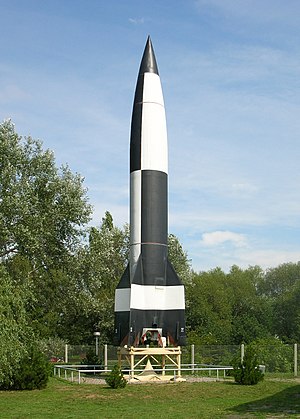Space Humanity Program
Search
V-2 rocket
Read in another languageWatch this pageEdit
"V-2" redirects here. For other uses, see V2.
The V-2 (German: Vergeltungswaffe 2, "Retribution Weapon 2"), technical name Aggregat 4 (A4), was the world's first long-range[4] guided ballistic missile. The missile, powered by a liquid-propellant rocket engine, was developed during the Second World Warin Germany as a "vengeance weapon", assigned to attack Allied cities as retaliation for the Allied bombings against German cities. The V-2 rocket also became the first man-made object to travel into space by crossing the Kármán line with the vertical launch of MW 18014 on 20 June 1944.[5]
Peenemünde Museum replica of V-2
TypeSingle-stage ballistic missilePlace of originNazi GermanyService historyIn service1944–1952Used by
Post-war:
United KingdomUnited StatesSoviet Union
Production historyDesignerPeenemünde Army Research CenterManufacturerMittelwerk GmbHUnit cost100,000 RM January 1944, 50,000 RM March 1945[1]Produced16 March 1942 – 1945 (Germany)
Some assembled post-warSpecificationsMass12,500 kg (27,600 lb)Length14 m (45 ft 11 in)Diameter1.65 m (5 ft 5 in)Warhead1,000 kg (2,200 lb); Amatol (explosive weight: 910 kg)
Detonation
mechanism
ImpactWingspan3.56 m (11 ft 8 in)Propellant
3,810 kg (8,400 lb) 75% ethanol25% water4,910 kg (10,820 lb) liquid oxygen
Operational
range
320 km (200 mi)Flight altitude
88 km (55 mi) maximum altitude on long-range trajectory206 km (128 mi) maximum altitude if launched vertically
Speed
Maximum: 5,760 km/h (3,580 mph)At impact: 2,880 km/h (1,790 mph)
Guidance
system
Gyroscopes to determine directionMüller-type pendulous gyroscopic accelerometer for engine cutoff on most production rockets[2][3]:225
Launch
platform
Mobile (Meillerwagen)
Research into military use of long range rockets began when the studies of graduate student Wernher von Braun attracted the attention of the German Army. A series of prototypes culminated in the A-4, which went to war as the V-2. Beginning in September 1944, over 3,000 V-2s were launched by the German Wehrmacht against Allied targets, first London and later Antwerp and Liège. According to a 2011 BBC documentary,[6] the attacks from V-2s resulted in the deaths of an estimated 9,000 civilians and military personnel, and a further 12,000 forced laborers and concentration camp prisoners died as a result of their forced participation in the production of the weapons.[7]
As Germany collapsed, teams from the Allied forces—the United States, the United Kingdom, and the Soviet Union—raced to capture key German manufacturing sites and technology. Wernher von Braun and over 100 key V-2 personnel surrendered to the Americans. Eventually, many of the original V-2 team ended up working at the Redstone Arsenal. The US also captured enough V-2 hardware to build approximately 80 of the missiles. The Soviets gained possession of the V-2 manufacturing facilities after the war, re-established V-2 production, and moved it to the Soviet Union.
Developmental history
Technical details
Production
Launch sites
Operational history
Countermeasures
Assessment
Unfulfilled plans
Post-war use
Surviving V-2 examples and components
See also
Notes
References
Further reading
External links
Last edited 17 days ago by Favonian

Content is available under CC BY-SA 3.0 unless otherwise noted.

Comments
Post a Comment